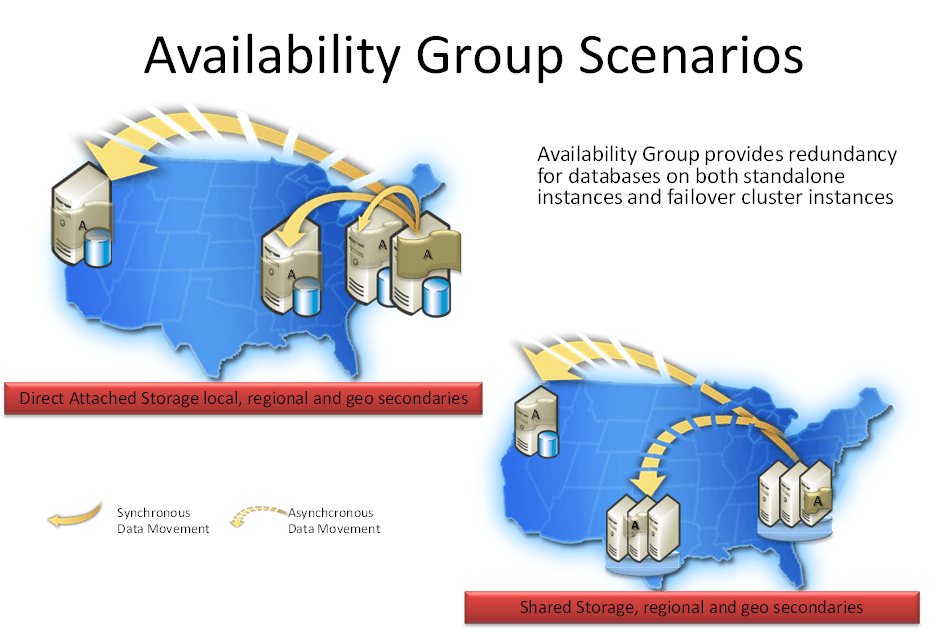The SQL Server team is hard at work on SQL Server vNext, code name “Denali”. They have a whitepaper out on their web site, “New Features in SQL Server Code-Named “Denali” Community Technology Preview 1” which you can download here.
As I do a lot of infrastructure work for people who really dig al this spatial and GIS related “stuff” I always keep an eye out for related information that can make their lives easier an enhance the use of the technology stack they own. Another part of the new features coming in “Denali” is Availability Groups. More information will be available later this year but for now I’ll leave you with the knowledge that it will provide for Multi-Database Failover, Multiple Secondaries, Active Secondaries, Fast Client Connection Redirection, can run on Windows Server Core & supports Multisite (Geo) Clustering as shown in the Microsoft (Tech Ed Europe, Justin Erickson) illustration below.
 Availability Group can provide redundancy for databases on both standalone instances and failover cluster instances using Direct Attached storage (DAS), Network Attached Storage (NAS) and Storage Area Networks (SAN) which is useful for physical servers in a high availability cluster and virtualization. The latter is significant as they will support it with Hyper-V Live Migration where as Exchange 2010 Database Availability Groups do not. I confirmed this with a Microsoft PM at Tech Ed Europe 2010. Download the CTP here and play all you want. Please pay attention to the fact that in CTP 1 a lot of stuff isn’t quite ready for show time. Take a look at the Tech Europe 2010 Session on the high availability features here. You can also download the video and the PowerPoint presentation via that link. At first I thought MS might be going the same way with SQL as they did with Exchange, less choice in high availability but easier and covering all needs but than I don’t think they can. SQL Server Applications are beyond the realm of control of Redmond. They do control Outlook & OWA. So I think the SQL Server Team needs to provide backward compatibility and functionality way more than the Exchange team has. Brent Ozar (Twitter: @BrentO) did a Blog on “Denali”/Hadron which you can read here http://www.brentozar.com/archive/2010/11/sql-server-denali-database-mirroring-rocks/. What he says about clustering is true. I’ use to cluster Windows 2000/2003 and suffered some kind of mental trauma. That was completely cured with Windows 2008 (R2) and I’m now clustering with Hyper-V, Exchange 2010, File Servers, etc. with a big smile on my face. I just love it!
Availability Group can provide redundancy for databases on both standalone instances and failover cluster instances using Direct Attached storage (DAS), Network Attached Storage (NAS) and Storage Area Networks (SAN) which is useful for physical servers in a high availability cluster and virtualization. The latter is significant as they will support it with Hyper-V Live Migration where as Exchange 2010 Database Availability Groups do not. I confirmed this with a Microsoft PM at Tech Ed Europe 2010. Download the CTP here and play all you want. Please pay attention to the fact that in CTP 1 a lot of stuff isn’t quite ready for show time. Take a look at the Tech Europe 2010 Session on the high availability features here. You can also download the video and the PowerPoint presentation via that link. At first I thought MS might be going the same way with SQL as they did with Exchange, less choice in high availability but easier and covering all needs but than I don’t think they can. SQL Server Applications are beyond the realm of control of Redmond. They do control Outlook & OWA. So I think the SQL Server Team needs to provide backward compatibility and functionality way more than the Exchange team has. Brent Ozar (Twitter: @BrentO) did a Blog on “Denali”/Hadron which you can read here http://www.brentozar.com/archive/2010/11/sql-server-denali-database-mirroring-rocks/. What he says about clustering is true. I’ use to cluster Windows 2000/2003 and suffered some kind of mental trauma. That was completely cured with Windows 2008 (R2) and I’m now clustering with Hyper-V, Exchange 2010, File Servers, etc. with a big smile on my face. I just love it!
